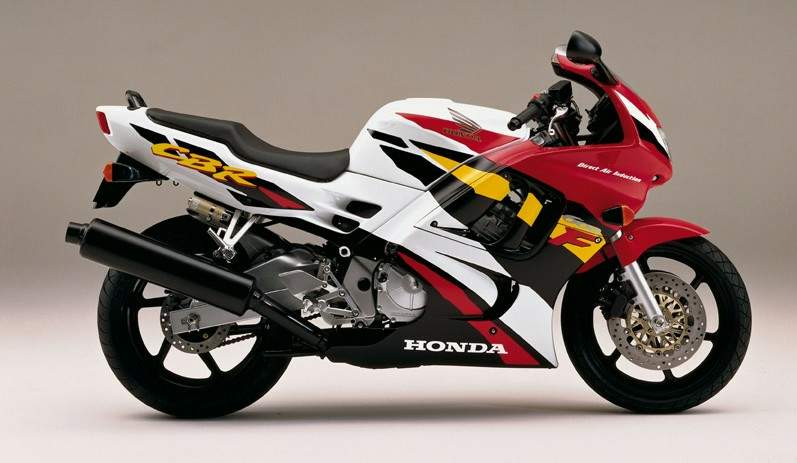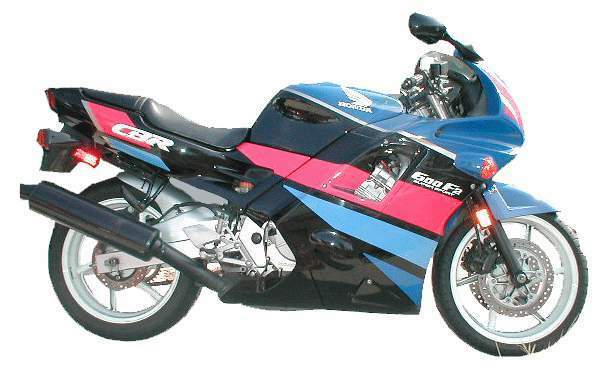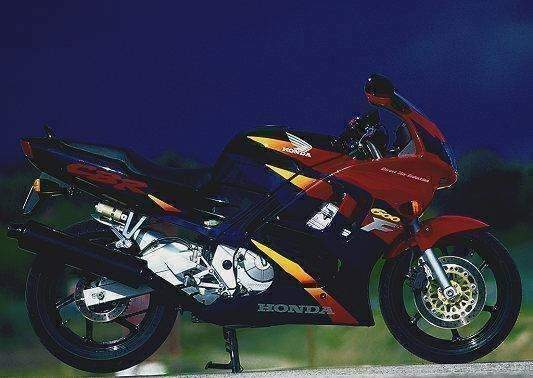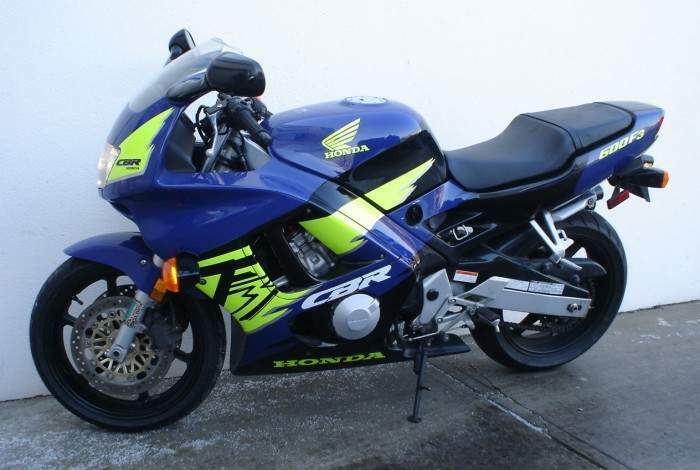Those of you who weren't riding before the year 2000 may find it difficult to imagine there was once a time when the sight of a Honda struck fear into riders of other brands. During the years of 1991-1998, it was almost an anomaly to see anything other than the Honda CBR600F2 and F3 on top of a 600cc magazine shootout or in the winner's circle.
For example, in 1991, Honda rider Miguel Duhamel (on board the new F2) won seven of nine races, completely dominating the AMA 600cc Supersport championship; Honda F2 riders won the other two races as well. If you wanted to win races in this era you needed to ride a Honda or else your chances weren't all that good.
The F2 was announced in late 1990 at $4998 and it promised to be a worthy follow-up to the original Honda Hurricane that debuted in 1987. The CBR600F2 had a liquid-cooled DOHC engine with a 65mm x 45.2mm bore and stroke that was even more over-square than the original at 63 x 48mm. The cam chain was moved to the right end of the crank to eliminate one crank journal, and compression was bumped up from 11.3:1 to 11.6:1. The new bike also featured 34mm flatslide CV carbs vs. the older model's 32mm round-slide units. With lighter pistons, crank and con rods, it was able to achieve a 500-rpm bump in the rev-limit to 13,000 rpm. The bike also had side mounted air scoops but they fed cool air under the tank and not directly into the 6.2-liter airbox.
The engine was known for making good top-end power without sacrificing the midrange, which is one of the things that made it so special. The cams were actually designed with midrange power in mind and the excellent cylinder head flow was rumored to be the secret to the top end power. The included valve angle was shrunk from 38 to 32 degrees, and a shim-under-bucket valve actuation replaced the old rocker arm assembly. This also allowed valve adjustments to jump from 5000 to 12,000-mile intervals.
Honda also fitted a smaller clutch and primary gears to the F2 that allowed the output shaft to be positioned 0.5 inches closer to the crank. In order to compensate for the smaller diameter clutch they simply added a few extra plates and mated it to a six speed tranny. Overall the new engine was 2 inches smaller and 0.6 inches narrower and 1.3 inches shorter than the old model. This change along with a shorter fuel tank allowed Honda designers to move the rider closer to the front wheel and improve handling.
The forks were upsized from 37mm to 41mm and featured preload adjustments, while a new single rear shock sported preload and rebound adjustments, in addition to a new box-section swingarm. Six-spoke RC30-style wheels were 3.5 x 17 inches in front and 4.5 x 17 inches out back. The chassis was a new twin-spar design but was still made from steel, with 25 degrees of rake and 3.7 inches trail with a 55.5-inch wheelbase. Front rotors were 275mm-diameter units squeezed by twin-piston slide-pin calipers. When fully tanked up, the F2 weighed a lean 455 pounds, making it the lightest bike in its class compared to the 490-pound Kawasaki ZX-6 or the 458-pound Yamaha FZR600.
Owners of the F2 report that it was a very balanced bike that could easily be street-ridden or raced on the track. Unlike the extremely narrow focus bikes of today, the earlier generation could really do it all. The dyno charts of 1991 show the CBR-F2 making a class leading 85 horsepower and quarter-mile times of 11.3 seconds at 120 mph. And it was not only the quickest and fastest bike in the 600cc class, it still delivered 42 mpg. Honda ruled the 600cc roost and would not face a serious challenge until the new Ninja ZX-6R arrived in 1995.
The Honda F2 remained unchanged until 1994 when it was bolstered by a new cartridge-style Showa fork with external rebound and preload adjustments. The '94 also got a new Showa rear shock with compression and rebound dampening adjustments as well as spring preload adjustment. Weighing in at 456 pounds with a full tank and three new colors, it was ready to take on the new Ninja ZX-6R (and usually the Honda won).
In 1995 Honda decided that it was time to raise the stakes again with the introduction of the new CBR600F3 that would run from 1995-1998. Though Honda already dominated the 600cc class and led every chart from race wins to retail sales, they knew without a full upgrade that their reign would soon come to an end.
Although the F3 looked similar to the F2, it was only skin deep, as both the engine and chassis were revised. The new 1995 F3 featured another bump in carb size up to 36mm. With the addition of ram-air induction, new fueling and breathing requirements were necessary in order to serve up another five horsepower over the older F2 (this included a system of hoses to maintain the same pressure in the float bowls as the airbox, otherwise when airbox pressure rose above ambient there would be no fuel flow through the main jet). Compression was bumped to 12.0:1 and the intake runners shortened by 5mm to increase intake velocity. A new exhaust was also part of the mix, as was a new low friction coating on the piston rings and crank bearings. Honda revised the ignition system to help control detonation with the higher compression engine. All the engine changes allowed a bump in the rev limit to 13,300 rpm and peak power of about 90 horsepower arriving at 12,000.
The F3 had upgraded front rotors-now measuring at 296mm-and a new 5-inch-wide rear wheel. The rear suspension had a revised linkage rate and a beefier swingarm pivot, while the fork received new triple clamps. Weight stayed about the same despite all the improvements, mostly due to little things like plastic headlight covers and a few other similar changes to offset the small weight gains in other areas.
Needle bearings were fitted in the tranny for better shifting, and a curved aluminum radiator helped with cooling. The new Honda also came with a new MSRP of $7299 which is a long way from the $4998 price in 1991. In 1995, the Kawasaki was $7899 and the Yamaha was a meager $6999 for reference. Honda decided to leave well enough alone in '96 and focused on new paint jobs fashioned after the Erion team and the factory Smokin' Joe's team. Retail bumped again to $7699.
The 1995 AMA 600 Supersport season was another good one for Honda, with Duhamel putting on a Honda seminar all year by winning eight races in a row en route to his second AMA 600 title. The Honda F3 won all 11 of the races that year, scoring a perfect shutout of the competition. This made four 600 titles in the Honda's five years of existence (Yamaha won the title in '94). You simply can't talk about 600cc racing in this time period without mentioning the Honda CBR600F2-F3.
Honda was beginning to feel threatened by the competition, so they again went back to the design well in '97 for another round of tricks. More power, better suspension as well as a new muffler and ignition mapping too. New forks and a new shock plus a resized 525 chain helped as well; retail was now $7799. While the Suzuki may have been a better track bike, its engine was peaky and it was not as good an all-around bike as the Honda. The Suzuki was lighter, but the better overall powerband of the Honda allowed it to run a slightly quicker quarter-mile, although the Kawasaki bested them both at the strip. All the 600s were now into the sub 11-second ET range and carried in excess of 150mph top speeds. The F3 remained unchanged for '98 until the all-new F4 was released in '99.
The F2 and F3 bikes were very sturdy bikes with only a few issues known to plague them. First was the hydraulic cam chain tensioner. Many owners reported failures and the easiest fix was to simply replace the oil-pressurized tensioner with a billet manual unit from APE (www.aperaceparts.com). The stocker was noisy and prone to failure while the manual unit is less expensive, easy to install and adjust.
The next biggest issue on the bike was the voltage regulator/rectifier. Many owners we spoke to reported having failures until they upgraded the unit completely instead of replacing it with another stock part. The stocker is known to overheat and die in as little as a few days and the result was a dead battery. If you are looking at a used F2 or F3, it can easily be checked with a voltmeter by simply testing the battery voltage at idle and again at 5000 rpm in neutral. If the voltage is not at or near 14.5V at 5000 rpm, the regulator is likely dead. Industrious owners however discovered that they could fit a GSXR1000 or a Yamaha R1 rectifier in its place. See www.cbrforum.com for more details. These can be scored off EBay and save you a lot of cash too.
F2 owners also reported issues with the vacuum-operated petcock that would stick on occasion. A quick fix is to fit a F3 or F4 petcock. Mechanically the bikes are bulletproof and despite widespread use in Europe by messengers and couriers, they have held up very well.
Since the bike was so popular, the aftermarket had plenty of goodies available. As usual, the most common mod was replacement of the exhaust system along with a jet kit. High flow air filters were also common for those so inclined. Re-gearing was another common way to boost low end acceleration provided you were willing to sacrifice some top speed. The most aggressive gearing that is still streetable is a one-tooth smaller front sprocket with a two-tooth larger on the rear. This results in impressive drive off the corners but of course raises rpm significantly on the highway, which can be annoying.
The bike handled well without a steering damper and we found only a few owners opting to install them. Unless track days were on their schedule it wasn't a requirement. A few enthusiasts upgraded the forks with new internals or in the case of the '91-'93 F2 they upgraded the old damping rod fork to a newer cartridge fork from the '94 F2 or later model F3. Upgraded rear shocks were offered by several manufacturers and were another way to decrease lap times and improve handling. Though the brakes were fairly low tech in their day, they did work well and most riders simply changed pads and/or lines as needed and didn't spend crazy money on rotors or calipers.
In order to get some feedback on the Honda CBR from an AMA-level race team we talked to Dan Kyle of Kyle Racing (www.kyleusa.com). During the peak of the Honda F2 and F3's life on the track, Dan was at Two Brothers Racing in '91 and '92 as a crew chief, and then he moved to Erion Racing in '93. Kyle was right in the middle of AMA 600 Supersport racing for several years and had a lot of good things to say about the bike. "Both the F2 and F3 bikes were very reliable on and off the track," said Kyle, including one story that was a testament to the Honda's reliability. "In 1996 we were at the track and had a brand new F3 engine in a bike and Doug Toland was riding it. After a few laps we noted that it started to smoke and it didn't let up so we brought him in off the track. After looking over the bike we realized that the entire cooling system was dry. It had been on the track circulating for several laps at race pace yet it never gave up. I later opened up the engine assuming it was toast but it wasn't. The cylinders were slightly out of round from the excessive heat but I simply rebuilt it anyway. After reassembly it made more power on the dyno than any other F3 we had built."
Dan reports that Supersport bikes of that era were making horsepower in the upper 90s with surprisingly close to stock preparation, other than building them at the high end of the tolerances to minimize friction losses and maximize power. Dan also revealed that the front suspension only required shim stack and spring changes, while the rear shock was usually a Fox or Öhlins unit.
As you can see the Honda CBR F2-F3 was a dominant bike and it can still offer you a great ride provided you find a good one on the used market. We checked the used values on NADA but since they don't publish data pre-1994 models, we have to start with the 1995s which are showing a retail of $2065. If you can find a mint 1996 expect to pay $2350 and the 1997-1998s are going for $2465-$2605. As exciting as the new sportbikes are today, this is proof that you don't have to spend $10K to have a good sportbike. The roots of today's bikes trace directly back to these great bikes of the past and though you will not see one on the podium, they can still serve duty for you as a reliable streetbike.





